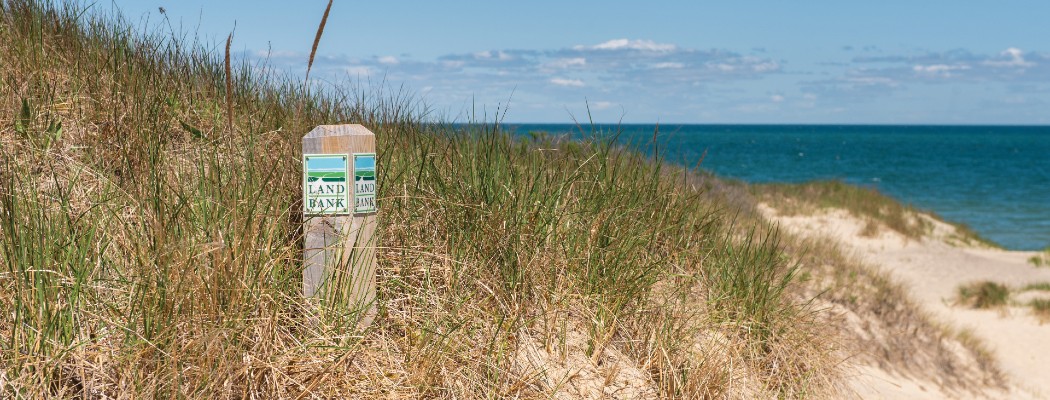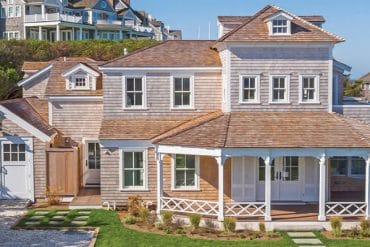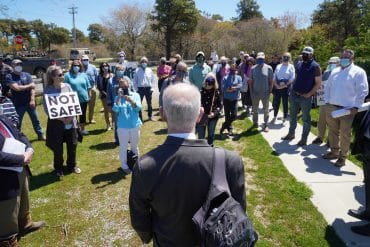The debate over the island’s conservation land.
It feels almost sacrilegious to ask the question: Does Nantucket already have enough conservation land? More than 50 percent of the island is now permanently protected from development thanks to the movement to preserve land on Nantucket that began in the 1960s and succeeded beyond all expectations. Today, island residents and visitors enjoy thousands of acres of pristine open space, huge tracts of critical wildlife habitat have been preserved in perpetuity, and Nantucket’s vast natural beauty has helped it become one of the most attractive destinations on the East Coast, if not the world.
 But some believe the conservation juggernaut has tipped the scales and manipulated the market in a way that has unintentionally contributed to and accelerated another crisis Nantucket is experiencing. With half the island now permanently off the market, they say the law of supply and demand in real estate has created an affordable housing nightmare that leaves few, if any, options for Nantucket’s working class. The median home price eclipsed $2.5 million in 2020. And there are only a small handful of homes available for under $1 million, while the rental market is as tight and expensive as ever.
But some believe the conservation juggernaut has tipped the scales and manipulated the market in a way that has unintentionally contributed to and accelerated another crisis Nantucket is experiencing. With half the island now permanently off the market, they say the law of supply and demand in real estate has created an affordable housing nightmare that leaves few, if any, options for Nantucket’s working class. The median home price eclipsed $2.5 million in 2020. And there are only a small handful of homes available for under $1 million, while the rental market is as tight and expensive as ever.
So some island housing advocates are indeed asking those delicate questions: Does the island already have enough conservation land? Is it time for some of the energy and resources that for so long have been dedicated to open space acquisition to be refocused on the affordable housing crisis?
They have set their sights on the Nantucket Land Bank, the first-in-the-nation public agency established in 1983 to fund open space preservation through a 2 percent real estate transfer tax. Since then, the Land Bank has spent nearly $350 million to acquire and protect 3,800 acres on Nantucket. Last year alone, amid a record-breaking year for island real estate sales, the Land Bank amassed a war chest of more than $35 million.
The windfall got island housing advocate Brooke Mohr thinking and set the wheels in motion for her citizen petition that would reallocate 25 percent of the Land Bank’s revenue from real estate transfers for affordable housing projects over a twenty-year period. “My thinking was, really, to stir the pot, to ask the fundamental question—knowing no community has unlimited resources—is it appropriate to revisit something that’s been in place for a long time, had huge success, but impacted the access to housing for year-rounders in a negative way through conservation of half our island’s acreage?” Mohr said. “I said I was going to throw it out and start a conversation. Boy it worked.”
The response to Mohr’s citizen petition, and the question it inherently asks—do we already have enough conservation land?—has been a resounding no. At least so far. The proposal has galvanized the island’s conservation groups and their supporters, even prompting the Nantucket Conservation Foundation—the private nonprofit that is the largest owner of conservation land on the island—to take a rare political stance on the issue.

“The Nantucket Conservation Foundation strongly supports the original charter of the Nantucket Island Land Bank and is strongly against any attempts to modify its intent,” the organization stated in a position paper released earlier this year. The Land Bank itself has published op-eds and distributed new stickers that read “Preserve the Land Bank,” while the island’s elected and appointed officials on the Select Board and Finance Committee have both weighed in strongly against Mohr’s proposal. “I think we can do both,” Nantucket Land Bank Executive Director Eric Savetsky said of generating funding for conservation and affordable housing. “I don’t think we have to hurt one to help the other.”
With nearly four thousand acres being managed by the Land Bank, Savetsky said, about half of the organization’s annual revenue goes to operating costs, maintaining its properties and debt service, with the remaining half dedicated toward land acquisition. In accordance with its original charter, the Land Bank also manages a host of recreational and agricultural properties, in addition to the Miacomet Golf Course. The warrant article, if approved, would slash that acquisition budget in half, Savetsky said, since the other expenses are financial obligations that are essentially baked in.
 We’re still at a critical time,” Savetsky said. “We’re looking at buying critical parcels. Maybe in five to ten years we ask is there anything left to buy? But it’s hard to imagine when that is. And it’s not now.”
We’re still at a critical time,” Savetsky said. “We’re looking at buying critical parcels. Maybe in five to ten years we ask is there anything left to buy? But it’s hard to imagine when that is. And it’s not now.”
During its review of the proposal, the Nantucket Finance Committee received more than 120 letters from citizens in opposition. “We believe the trade-off should not be conservation vs. affordable housing,” the committee members wrote in their negative motion to Town Meeting voters, who will consider the proposal as Article 97 on June 5.
Nevertheless, Mohr and a group of housing advocates have remained steadfast. Many of the islanders who may quietly support their proposal, they say, are too busy working to pay their rent or mortgage to write letters and attend meetings. But they’re out there. The crisis in conservation is over, they say. It’s time to declare victory.
“I’ve been saying it: We do have enough [conservation land],” says island resident Peter Hoey, a supporter of Mohr’s petition. “In 2003, having taken all the vacant property, I think the Land Bank should have popped the champagne, taken a victory lap and become less active in the market. From that point on, they went from being part of the solution to being part of the problem. At this point, housing is so much more of a critical need to the island than open spaces.”

In the early 1980s, when Nantucket’s Planning Department first contemplated the idea for what would become the Land Bank, the thought of having enough or even too much conservation land seemed far-fetched. But it’s a scenario then Planning Director Bill Klein contemplated might eventually come. “It’s a very interesting topic, and one that we kind of guessed would come up at this point,” Klein said from his home on Fair Street. He’s been out of local politics for years, but as one of the architects of the original legislation that created the Land Bank, he’s still following the issue closely. “Back in the days when we developed the concept for the Land Bank, we thought there’s going to come a time when people say, ‘Do we really need this anymore?’ or ‘Let’s divert this cash to some other worthy purpose.’ None of these questions are easily answered.”
Klein says part of the answer lies in the “holding capacity” for Nantucket under existing zoning regulations, sometimes called a buildout analysis. The most recent analysis for the island—completed by Worcester Polytechnic Institute students in 2018—included a hypothetical “max buildout” scenario that showed the potential for 5,461 new dwellings, or 52 percent total growth. The town’s Planning & Land Use Services Department is preparing for a new buildout analysis this year.
“If we assume everything gets built out, how many houses will that be? What are the shopping lines at the Stop & Shop going to look like when we’re built out? What’s the backup at Sparks Avenue and Surfside Road look like when we’re built out?” Klein asked. “There’s all these public costs that have to be paid for, and the quality of life.”
 Neil Paterson, the chairman of the elected five-person Land Bank Commission, which determines new land acquisitions, suggested housing advocates should be proposing to add half a percent to the existing Land Bank transfer fee for affordable housing projects, rather than trying to take something away. The island has the capacity and the advocacy to find funding for both priorities, he said, adding, “It’s not either or, or black or white; we can do both together. The two causes are very unfortunately being pitted against each other.”
Neil Paterson, the chairman of the elected five-person Land Bank Commission, which determines new land acquisitions, suggested housing advocates should be proposing to add half a percent to the existing Land Bank transfer fee for affordable housing projects, rather than trying to take something away. The island has the capacity and the advocacy to find funding for both priorities, he said, adding, “It’s not either or, or black or white; we can do both together. The two causes are very unfortunately being pitted against each other.”
Opponents of Mohr’s petition also point to numerous other on-going efforts to address Nantucket’s affordable housing crisis that wouldn’t cost the Land Bank any funding. While the long-discussed Housing Bank legislation, which would mimic the Land Bank transfer fee but place the tax on sellers, rather than buyers, remains stalled in Boston, the town has taken steps toward directing more resources toward affordable housing projects in recent years.
In 2019, Town Meeting voters approved the so-called Neighborhood First petition, which allocated $20 million in taxpayer dollars toward affordable workforce housing inventory. Properties on Orange Street and Fairgrounds Road have been acquired with those funds, and housing plans are in the works with the local nonprofit Housing Nantucket. The town is also developing municipal land at 6 Fairgrounds Road that will eventually include sixty-four units of rental apartments, twenty single family residences, as well as seasonal dormitory style housing that could accommodate roughly fifty seasonal employees. Meanwhile, Town Meeting voters will consider another $7.5 million in taxpayer funding for affordable housing initiatives at this year’s Annual Town Meeting. All while several other major private housing projects with some affordable units—Richmond Great Point off Old South Road and Surfside Crossing off South Shore Road—are under construction or in the works.
Even so, Mohr says, those investments pale in comparison to the scale of the problem the island faces when it comes to housing. “The Land Bank is just buying land. We’ve got to buy land and then build houses on it, and people think we’re going to do that with $25 million? They’ve had $400 million,” Mohr said. “Not everyone has the time and resources to take advantage of open spaces the way some of us do. The people working three jobs to pay rent are not walking trails or taking care of beach access. But I don’t know too many business owners who could run their business without employees and the economy that serves people playing golf and vacationing here. It’s hard for me to comprehend a community that is so reliant on each other because of our geography, and always talks about how amazing it is, but we still haven’t found a way to solve this crisis as a priority for all of us, in the same way we saw the conservation movement as a good thing for all of us. It’s frustrating. It’s demoralizing.” Island voters will decide the fate of Mohr’s petition at the 2021 Annual Town Meeting on Saturday, June 5.






